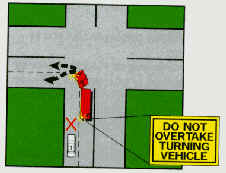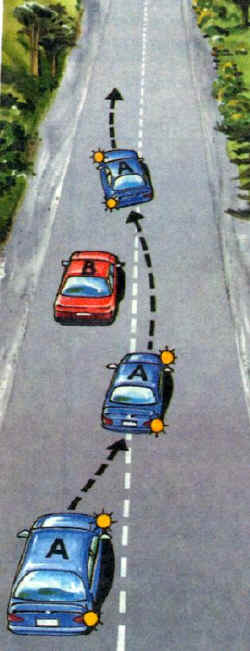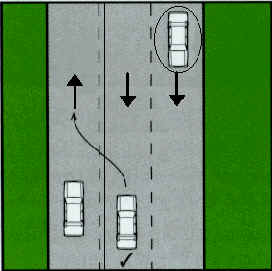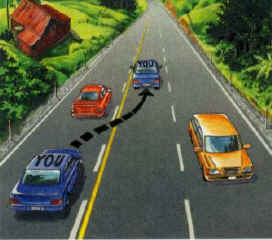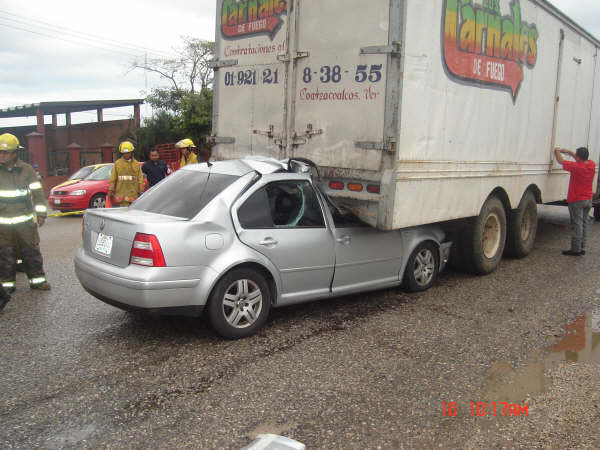Chapter 34: SHARING THE ROAD WITH TRUCKS
(This information has been supplied by Mr. Rod Hannifey; a professional truck driver and road safety advocate)
Heavy vehicles are large and slow and not very manoeuvrable. Overtaking these vehicles can be dangerous. The rear trailer can often obstruct vision of the road ahead and can sway side to side over the road. Other drivers may get impatient and overtake when they have no view of the road ahead.
COMMON TRUCK TYPES
RIGID: 12.5 metres long, speed limited to 100 km/hr
RIGID & DOG: 19 metres long, speed limited to 100 km/hr
SEMI TRAILER: 19 metres long, speed limited to 100 km/hr
B-DOUBLE: 26 metres long, speed limited to 100 km/hr with "LONG VEHICLE" sign at rear
TRIPLE ROAD TRAIN: 53.5 metres long, speed limited to 90 km/hr with "ROAD TRAIN" sign at rear
TRUCKS WITH AN OVERSIZE LOAD
If a car or 4WD vehicle approaches you carrying the "OVERSIZE LOAD AHEAD" sign be prepared to move over, slow down and stop, since following close behind will be a truck that is some combination of very long, high, wide or heavy. The pilot vehicle escorting this over-size truck may even flag you down and warn you to pull off the road as the truck requires the whole road width.
TRUCKS TURNING
The DO NOT OVERTAKE TURNING VEHICLE SIGN fitted to the rear of trucks and trailers allows the truck to legally turn from the second or third lane from the kerb if needed to safely get around the corner. This is not a invitation for cars to cut down the side of the truck, and if you move into this space inside the turning vehicle you may be in a blind spot often to the left and rear of the truck cab. Please stay back and remember if you can’t see the truck driver in their mirrors they can’t see you.
In the example shown above, when the truck pulls into the right lane but has its left indicators on, do not pull up the inside left lane, as the truck will turn across you path. At smaller roundabouts a truck may require both lanes to get through the roundabout. Leave space for the truck.
BRAKING DISTANCES
A truck requires a larger braking distance than a car. Please don’t cut in front of a truck approaching a red light, roundabout or even in traffic. When approaching a stale green light at an intersection, be aware of the traffic around you. If the lights change to orange and you decide to brake hard will following vehicles be able to stop. At an orange light you are required to stop but only if it is safe to do so. If not continue through the intersection.
ACCELERATING DISTANCE
A fully loaded truck takes time to accelerate to the speed limit. If the truck can keep moving as it coasts towards the red lights, there will be less delay for all traffic when the lights change. Likewise a truck driver may accelerate to the speed limit before a hill to reduce delay for following motorists. As such watch your speed and avoiding delaying other traffic by unnecessarily slowing the truck.
OVERTAKING
Unsafe overtaking is something truckies see all too often. People can become impatient behind trucks on hills or when there are few passing opportunities. Some people take a very large risk for only a few seconds gain.
So allow plenty of room, pass quickly but safely and pull back in only when you can see both headlights of the truck in your rear view mirror. This allows a safe space, but don’t then slow in front of the truck.
Before attempting to overtake ask yourself the following;
- What will you achieve?What are the risks?Is it safe and is it legal?How far is it to the next overtaking lane?
- What type of truck are you overtaking?
It is also important to avoid being pressured into overtaking by other following vehicles. Keep your cool and if necessary let them pass.
A STEP BY STEP GUIDE TO SAFE OVERTAKING
1. POSITIONING: If it becomes necessary to overtake do not tailgate the vehicle ahead as it will greatly reduce forward vision. Maintain a safe following distance.
2. SCANNING: Scan the road for approaching traffic, ensure you have enough space to safely complete the manoeuvre, check you know where the road goes next and that there are no dips or crests hiding vehicles. Some truck drivers may even flash their indicators to let you know it is safe to overtake them (in this situation, don't just assume it is safe)
3. INDICATE: If safe indicate your intentions and check no one else is attempting to overtake you and the vehicle ahead.
4. PULL OUT: Pull out before accelerating forward so the driver ahead knows you are coming. Blip your horn if necessary to alert this driver.
5. THE RETREAT: If due to the unexpected or a miscalculation you are not going to make it, brake firmly and attempt to steer in behind the vehicle again. Do not accelerate, hope and pray.
6. THE FINISH: Pull in as soon as you can see the vehicle you have passed headlights in your centre rear vision mirror. A wave of thanks to the driver may be constructive.
OVERTAKING LANES
On major highways keep a look out for "Overtaking Lane Ahead" signs, these are usually placed 5 km, 2 km and several hundred metres out from the passing lane. Whenever possible leave your overtaking to these dual lanes. If not overtaking keep left.
A scenario which usually alarms many inexperienced drivers in overtaking lanes is shown below. Here an approaching driver, enters one of the lanes in your direction to overtake another vehicle. This is legal in the example shown.
KEEP LEFT UNLESS OVERTAKING
BEING OVERTAKEN
If being overtaken by a truck please monitor your speed, some drivers inadvertently speed up, some speed up deliberately.
With all new trucks over 12 tonne speed limited a truck just cannot accelerate faster due to its mass and speed limiting. This truck’s engine is electronically controlled and will not power the truck past 100 km/hr. Only gravity downhill will take it faster.
A problem is often created by a car accelerating from 85-90 km/hr to 100 km/hr once an overtaking lane is reached only to slow again once the passing opportunity has passed. As a truck driver we often wonder if these same drivers are then annoyed by the truck following too close. Be a large vehicle this truck is far safer in front of than right behind you. Watch your speed and if a truck catches up maintain your speed.
ROAD COURTESY
Your licence is a privilege and not a right. Your attitude to others and their actions will determine whether your life on the road will be one of stress and aggression or of safely getting home. All of us will occasionally suffer from another drivers act of indifference or stupidity and only better driver education will help people to drive safer and all road users will benefit. I’m certain that a wave of sorry or thanks as applicable is far better than an escalation of a situation.
ROAD POSITIONING
As a professional truck driver I am amazed at how many drivers travel much closer to the centre line than is necessary. My truck occupies much of its lane, as such approaching traffic needs to create a buffer zone. Increase your own safety by the best use of the lane space, especially when towing a trailer or caravan and be even more aware of your position on the road.
If parking on the side of the roadway whether just for a minute, broken down or even if pulled over by the police, park well clear were possible. Police officers are instructed to park further to the right of the vehicle they stop, that gives them a safety corridor beside the other vehicle to protect the police from passing traffic. But some people only park centimetres from the fog line (the unbroken line on the left of the roadway) and with trucks using all the road this leaves little room for error.
NARROW ROADS
On narrow country roads be prepared to put your left hand wheels off the bitumen when a truck comes the other way. Don’t fight the truck for the bitumen. When the truck gets off the bitumen you might have upwards of 20 tyres throwing rocks at your car. On very narrow outback roads it may be necessary to get off the bitumen all together. If its wet and you get stuck the truck can pull you back on, but if the truck goes off the bitumen it might be stuck there for days.
HEADLIGHTS
Because of the increased braking distance required by a truck, the trucks headlights are usually much more powerful. When you see the lights of an approaching vehicle dip, or you see them flashed approaching a crest or curve, dip your lights. By waiting till you see the other vehicle before you dip you are momentarily blinding the oncoming driver. If coming up behind a truck dip early rather than when right behind. Trucks mirrors can be 15 times larger and don’t have an anti-glare position. When you move to overtake don’t throw your high beam on until past the trucks mirrors.
ROUNDABOUTS
Roundabouts can cause problems with car drivers not allowing for the need of the truck to possibly use all of the roadway. The do not overtake turning vehicle sign applies so you should stay behind the truck. A truck will try to still be rolling on entering a roundabout, the truck is not racing but trying to lessen the delay to all traffic. If a loaded B-Double has to move off from a standstill, every vehicle will have to wait for the truck.
TRUCK CRASHES
In only 25% of Australian truck crashes involving more than 1 vehicle the truck driver is deemed at fault.
THE TRUCKING INDUSTRY
Australia’s road transport industry is one of the most cost efficient in the world and every single one of us benefits from this worlds best practice. From your breakfast to your furniture, your fuel and every other item you use is carried on a truck at some time. So just consider the time on the road and way from home and the job done by Australia’s truckies delivering goods throughout Australia and share the roads for your safety and that of all road users.
Thanks and safe traveling.
(Written by Joel Neilsen, Managing Director, Safe Drive Training)


